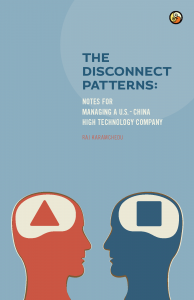- Full Title: The Disconnect Patterns: Notes for Managing a U.S.-China High Technology Company
- Author: Raj Karamchedu
- Language: English
- Print Length: 224 Pages
- Print ISBN-13: 978-0-9845762-5-8
- EPUB ISBN-13: 978-0-9845762-6-5
- Trim Size: 5.5″ x 8.5″ (13.97 x 21.59 cm)
- Publisher: Saaranga Publishers
- Published: November 2012
This is a partial list of contents of the English version.
Table of Contents
KNOWING THE DISCONNECT PATTERNS
- Chapter 1 – The Bad News
- Chapter 2 – The Arrival of the Stranger
- Chapter 3 – Defining the Disconnect Patterns
- Chapter 4 – Defining the Execution Skill in a China-U.S. Company
FINDING THE DISCONNECT PATTERNS
- Chapter 5 – Beijing, China
- Chapter 6 – Disconnect Patterns in AE (Applications Engineering)
- Chapter 7 – Disconnect Patterns in FAE (Field Applications Engineering)
- Chapter 8 – Not All Disconnect Patterns Are Same
- Chapter 9 – Disconnect Patterns in Sales
- Chapter 10 – Disconnect Patterns in Marketing
- Chapter 11 – A Cloud of Unknowing
- Chapter 12 – Disconnect Patterns in Engineering
- Chapter 13 – Disconnect Patterns in Human Resources
- Chapter 14 – Disconnect Patterns in Operations
- Chapter 15 – One More Session with China Marketing
DEALING WITH THE DISCONNECT PATTERNS
- Chapter 16 – Silicon Valley, California, U.S.A.
Disconnect Pattern 1
The U.S. manager demands focus from the China team, but at the same time, causes disruption by ignoring the China manager’s authority.
Disconnect Pattern 2
Same company, but the reward and bonus scheme in the China office is out of sync with the U.S. office.
Disconnect Pattern 3
Both U.S. and China teams work equally hard, but there is no appreciation of China team’s work.
Disconnect Pattern 4
China office wants to be a part of core product development, but it repeatedly leaks confidential future-product documents to the competition.
Disconnect Pattern 5
China teams say English language is no problem, but poor documentation by the China teams still persist.
Disconnect Pattern 6
China office says they admire the U.S. management process, but the China upper management repeatedly disrupts the company process by changing the priority without discussion.
Disconnect Pattern 7
Though Emory calls itself a global company, the U.S. team does not give importance to the China team.
Disconnect Pattern 8
The U.S. office wants to be in China market, but it does not share company plans with China office employees.
Disconnect Pattern 9
The U.S. office wants to sell to China customers, but the feedback from the China customer is not taken seriously.
Disconnect Pattern 10
The U.S. office says we are all one team, but the China team is allocated insufficient project time.
Disconnect Pattern 11
The U.S. team expects to interact with the China team in a professional way, but feels the China management style as strange and dysfunctional.
Disconnect Pattern 12
The U.S. employees are frustrated that their China colleagues won’t take any action unless they have the “authority.”
Disconnect Pattern 13
The China team wants to scale up and grow, but does not seem to appreciate open and clear communication.
Disconnect Pattern 14
The U.S. office wants to succeed in the China market, but builds the China marketing team by simply moving low-performing technical staff into marketing roles.
Disconnect Pattern 15
In China, employees say they have the project management skills, but task ownership and task management is still a big problem.
Disconnect Pattern 16
The China office wants to do a full product, but the China marketing teams do not take charge and lead.
Disconnect Pattern 17
The U.S. marketing team promotes to China customers, but continues to approach them with a tin ear.
Disconnect Pattern 18
In pricing the product for the China market, there is still a strategy mismatch between the U.S. and China.
Disconnect Pattern 19
The U.S. office wants to capitalize on China customer demand, but does not understand China customer demand pattern.
Disconnect Pattern 20
The U.S. office prides itself on execution but the response to China from the U.S. is very slow.
